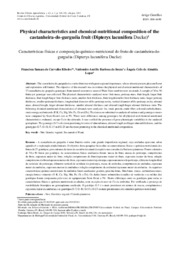Physical characteristics and chemical-nutritional composition of the castanheira-do-gurguéia fruit (Dipteryx lacunifera Ducke).
Physical characteristics and chemical-nutritional composition of the castanheira-do-gurguéia fruit (Dipteryx lacunifera Ducke).
Resumo: The castanheira-do-gurguéia is a native fruit tree with great regional importance, whose almond present pleasant flavor and exploration still limited. The objective of this research was to evaluate the physical and chemical-nutritional characteristics of 23 castanheira-do-gurguéia genotypes from natural occurrence areas of Piauí State southwestern savannah. A sample of 30 to 50 fruits per genotype was collected. The physical characteristics analyzed were: fruit mass, pericarp mass, fruit length, larger fruit thickness, fruit length/larger fruit thickness ratio, smaller fruit thickness, fruit length/smaller fruit thickness ratio, larger pericarp thickness, smaller pericarp thickness, longitudinal diameter of the pericarp cavity, vertical diameter of the pericarp cavity, almond mass, almond length, larger almond thickness, smaller almond thickness and almond length/larger almond thickness ratio. The following chemical-nutritional characteristics of almonds were analyzed: fat, crude protein, crude fiber, ash total carbohydrates, crude energy and minerals (P, K, Ca, Mg, Mn, Fe, Cu and Zn). The data were submitted to analysis of variance and genotypes means were compared by Scott-Knott?s test at 5%. There were differences among genotypes for all physical and chemical-nutritional characteristics evaluated, except Ca in the almonds. It was verified the presence of great phenotypic variability in the analyzed germplasm. The genotype G-3 is the most promising in terms of almond mass, almond length and larger almond thickness, and the genotypes G-7, G-10, G-13 and G-23 are the most promising in the chemical-nutritional composition.
Ano de publicação: 2012
Tipo de publicação: Artigo de periódico
Unidade: Embrapa Meio-Norte
Palavras-chave: Cerrado piauiense, Genética Vegetal, Noz
Observações
1 - Por padrão são exibidas publicações dos últimos 20 anos. Para encontrar publicações mais antigas, configure o filtro ano de publicação, colocando o ano a partir do qual você deseja encontrar publicações. O filtro está na coluna da esquerda na busca acima.
2 - Para ler algumas publicações da Embrapa (apenas as que estão em formato ePub), é necessário ter, no celular ou computador, um desses softwares gratuitos. Sistemas Android: Google Play Livros; IOS: iBooks; Windows e Linux: software Calibre.
Acesse outras publicações
Acesse a Base de Dados da Pesquisa Agropecuária (BDPA) para consultar o acervo completo das bibliotecas da Embrapa.

